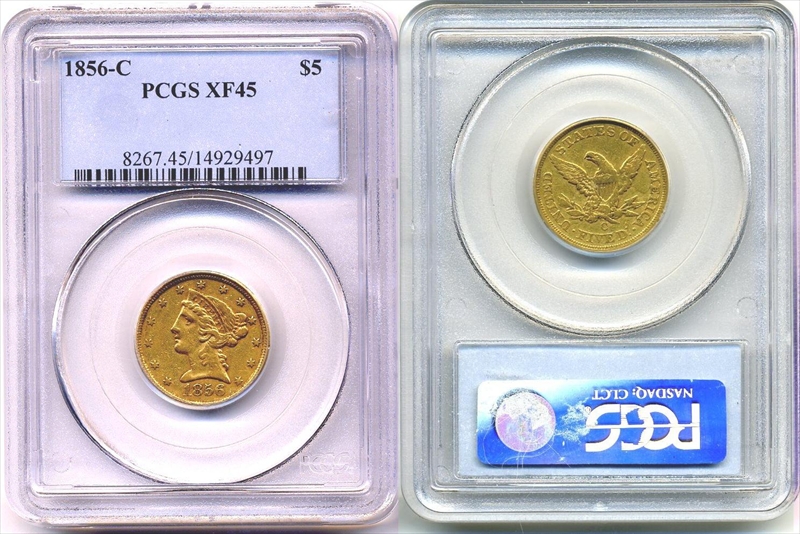1856-C $5 XF45 认证号14929497, PCGS号8267
专家评论
Doug Winter
The 1856-C half eagle is still regarded as a fairly common date by most non-specialists. In my opinion, it remains an underrated and undervalued issue. Coincidentally, the same remains true for the 1856-dated half eagles from all of the branch mints.Although is has become a bit more available in the past decade, the 1856-C is still among the scarcest Charlotte half eagles from the 1850s. It is most often seen in Very Fine and Extremely Fine grades. It is very scarce in the lower About Uncirculated grades and rare in properly graded AU55 to AU58. It is extremely rare in Uncirculated with approximately a half dozen known, the finest of which is a PCGS MS63 that seems to have first surfaced in 2005.
Since the publication of the last edition of this book, the 1856-C has become slightly more available in Uncirculated. I believe that a small hoard has been discovered and that a few coins have entered the market, possibly to “test the waters.”
STRIKE: This is an issue that is not typically seen with a good overall strike. There is often considerable weakness seen on the curls around the face and the curl below the ear of Liberty can be blunt and flat. The top of the head often shows weakness and the bun may be flat as well. Many of the starts are weak at he centers (usually at the right) and there is often weakness on the denticles at he right as well. Many 1856-C half eagles also have some weakness on the date, typically at the base of the 85. The reverse shows weakness at the juncture of the shield and the left wing and on the upper portion of the right wing. The legs are sharp except for the middle of the right on which is typically weak. The mintmark is very sharply struck unlike other Charlotte half eagles from this decade.
SURFACES: Numerous deep abrasions can be seen in the fields and most examples have negative eye appeal as a result of the marks. These are compounded by digs and scratches which are often seen as well. A few have mint-made die rust below the eagle’s left wing and, more extensively, across the lower left obverse. A small number have matte-like surfaces from exposure to saltwater. These typically display the sharpness of Uncirculated but are accorded the value of an Extremely Fine with normal surfaces.
LUSTER: The luster seen on some high grade pieces is soft and frosty while on others the texture is grainier. In my opinion, the frosty pieces are far more attractive and worth a premium as a result. It is very hard to find an example of this date with good luster. This is due to the fact that an inordinate number have been harshly cleaned at one time. In addition, many show enough wear or severe marks that the luster is impaired.
COLORATION: Light to medium green-gold is the natural range of coloration for the 1856-C half eagle. More often than not, this color has long since been scrubbed away and most are now a dull yellow-gold or they have an unnaturally bright yellowish hue.
EYE APPEAL: The typical 1856-C half eagle has below average eye appeal. This is primarily due to excessive marks on the surfaces as well as inferior luster and softness of strike. Most of the attractive, relatively high grade examples that I have seen are new to the market and may come from a small hoard that was discovered in the past decade.
DIE CHARACTERISTICS: The denticles on the obverse from 2:00 to 6:00 are often defective, either from rust or an improper collar. Some pieces (Heritage 2006 ANA:507 and others) have perfect denticles in this area and these may represent the earliest die state for this issue.
DIE VARIETIES: There is a single variety known.
Variety 1 (formerly 24-J): The 1 in the date is a little closer to the bust than to the denticles. The 6 is centered between the bust and the denticles. The reverse is the same as described for 1855-C Variety 1.
David Akers (1975/88)
This low mintage date (by Charlotte Mint standards) is very rare in all grades and virtually unobtainable better than EF. I have seen a few AU specimens but never a fully uncirculated piece. VF or EF is just about all one can expect to find of this date.PCGS #
8267
设计师
Christian Gobrecht
边缘
Reeded
直径
21.65 毫米
重量
8.36 克
铸币数量
28457
金属成分
90% Gold, 10% Copper
更高评级数量
83
评级较低的钱币数量
43
地区
The United States of America
价格指南
PCGS 数量报告
拍卖 - PCGS 评级的
拍卖 - NGC 评级的
稀有性和存量估计 了解更多
| 所有评级 | 500 |
| 60或以上 | 10 |
| 65或以上 | 0 |
| 所有评级 | R-6.0 |
| 60或以上 | R-9.5 |
| 65或以上 | R-10.1 |
| 所有评级 | 96 / 112 TIE |
| 60或以上 | 59 / 112 TIE |
| 65或以上 | 1 / 112 |
| 所有评级 | 136 / 218 TIE |
| 60或以上 | 87 / 218 TIE |
| 65或以上 | 1 / 218 |
状况普查 了解更多
| #1 MS63 PCGS grade |
| #2 MS61 PCGS grade |
| #2 MS61 PCGS grade |
| #2 MS61 PCGS grade |
| #2 MS61 PCGS grade |





















